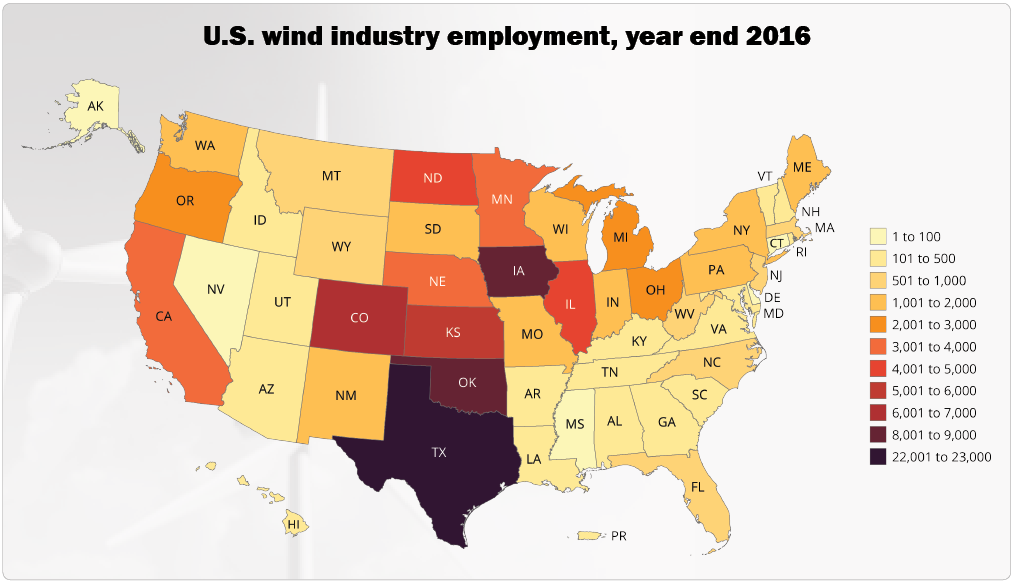Climate and clean energy progress continues in spite of Clean Power Plan repeal rumors
 According to news reports, Environmental Protection Agency (EPA) Administrator Scott Pruitt is planning to start the process of repealing the Clean Power Plan very soon.
According to news reports, Environmental Protection Agency (EPA) Administrator Scott Pruitt is planning to start the process of repealing the Clean Power Plan very soon.
This seriously flawed and misguided effort would be a dangerous step backwards for public health and climate protections.
However, as the Trump Administration continues to unravel these protections, the transition to a clean energy future is accelerating. States, cities, and power companies are responding to the ongoing attacks by forging ahead with ambitious actions to slash carbon pollution in order to respond to the threat of climate change and accelerate the clean energy revolution.
Clean Power Plan repeal?
The Clean Power Plan is a common-sense rule to safeguard public health by reducing carbon pollution from power plants to 32 percent below 2005 levels by 2030.
The Clean Power Plan would prevent:
- 3,600 premature deaths each year
- 1,700 heart attacks each year
- 90,000 asthma attacks each year
Administrator Pruitt reportedly intends to propose repealing the Clean Power Plan in the coming days.
If so, EPA will likely issue an “Advance Notice of Proposed Rulemaking” (ANPR) to solicit public input on a replacement rule – a protracted process that is likely to lead to a far weaker standard.
The ANPR process could lead to years of harmful and unjustified delay in implementing urgently needed limits on carbon pollution from fossil fuel power plants.
Forging ahead to a clean energy future
The U.S. power sector has already made enormous strides in deploying clean energy resources and slashing greenhouse gas emissions.
- Wind and solar comprised more than 60 percent (roughly 16.5 gigawatts) of new utility-scale generating capacity added in 2016.
- In March of this year, wind and solar exceeded ten percent of the nation’s electricity generation for the first time in history – even as coal’s share of the energy mix has declined to historic lows.
- The clean energy sector now employs more than three million Americans, and continues to grow rapidly:


Globally, the International Energy Agency (IEA) reported yesterday that renewables accounted for almost two-thirds of new capacity installed.
- Solar additions worldwide grew faster than any other fuel last year, including coal and natural gas.
- Over the next five years, the IEA projects renewable capacity to grow by over 920 gigawatts – a 43 percent increase by 2022.
Meanwhile, by the end of 2016, carbon pollution from U.S. power plants had already declined to 25 percent below 2005 levels – meaning the power sector is already almost 80 percent of the way to achieving the Clean Power Plan’s 2030 targets.
A new report by the Institute for Policy Integrity highlights the falling costs of complying with the Clean Power Plan. The report points to several market and policy developments including low natural prices, declining renewable energy costs, the 2015 renewable energy tax credit extensions, and state programs supporting the adoption of clean energy technologies.
The Clean Power Plan targets have become a floor for forward-looking states and companies that acknowledge the Clean Power Plan was a first step towards realizing the promise of a low-carbon power sector.
Yet this shift towards clean energy – driven by market forces and accelerating subnational action – is no substitute for decisive federal action that will ensure continued and accelerated progress in achieving the emissions reductions required to stem the tide of climate change.
The U.S. Energy Information Administration projects that without the Clean Power Plan, carbon emissions from the power sector will increase by 2030 – reversing the current downward trajectory in the United States and leaving the country behind as the global clean energy revolution continues.
To keep us moving forward, state and local officials are stepping up their game by cutting carbon pollution and switching to clean energy in spite of — and in direct response to — President Trump’s rollbacks.
- Fourteen states and Puerto Rico, accounting for more than 10 percent of U.S. carbon emissions from the power sector, pledged as part of the new U.S. Climate Alliance to reduce their greenhouse gas emissions consistent with the goals of the Paris Agreement, as well as meet or exceed their Clean Power Plan targets.
- 381 mayors (and counting) representing more than 67 million Americans also pledged to honor the Paris Agreement goals and work to meet the 1.5° Celsius global temperature target. Dozens of cities have committed to move to 100 percent clean energy.
- Colorado Governor John Hickenlooper signed an executive order in July 2017 committing the state to slash greenhouse gas emissions to 26 percent below 2005 levels by 2026, consistent with U.S. goals under the Paris Agreement. “The vast majority of our residents, and indeed the country, expect us to help lead the way toward a clean and affordable energy future,” Governor Hickenlooper said in a press release.
- Nine states comprising the Regional Greenhouse Gas Initiative (RGGI) in August announced a proposal to cut carbon pollution from the power sector an additional 30 percent between 2020 and 2030 – a 65 percent reduction below the original 2009 pollution cap. The proposal demonstrates bipartisan commitment to combat climate change, with five Republican and four Democratic governors helming the RGGI states (Connecticut, Delaware, Maine, Maryland, Massachusetts, New Hampshire, New York, Rhode Island, and Vermont). Meanwhile, both New Jersey gubernatorial frontrunners have pledged to rejoin RGGI after this year’s election.
- Virginia regulators are working to establish a “trading-ready” program to slash power plant carbon emissions in response to an executive order Governor Terry McAuliffe signed in May 2017. “Today, I am proud to take executive action to cut greenhouse gases and make Virginia a leader in the global clean energy economy,” Governor McAuliffe said when he signed the order.
- California affirmed its position as a global leader on climate progress with a bevy of actions in the past year. In September 2016, legislators passed SB 32, which requires the state to slash greenhouse gas emissions to 40 percent below 1990 levels by 2030. In July 2017, the state secured a 10-year extension to its landmark cap-and-trade program and strengthened tools to improve local air quality in a bipartisan effort. “All over the world, momentum is building to deal seriously with climate change,” Governor Jerry Brown said in July. “Despite rejection in Washington, California is all in.”
- At least 20 states and the District of Columbia have adopted ambitious greenhouse gas reduction targets, with most aiming for an 80 percent reduction by 2050 below baselines ranging from 1990 to 2006. Twenty-nine states and D.C. have binding renewable portfolio standards in place, while eight more have set renewable portfolio goals. Twenty states have set mandatory energy efficiency targets, while eight more have set energy efficiency goals.
The nation’s largest power companies are similarly pledging to slash carbon pollution and deploy renewable energy resources as they embrace the rapid transition to a clean energy economy.
- The CEO of American Electric Power (AEP), the country’s largest generator of electricity from coal, had this to say in response to President Trump’s decision to withdraw the U.S. from the Paris Agreement: “I think it’s really important for us to stay engaged from an international community standpoint, particularly addressing large issues. And not withstanding that, we’re continuing on our path of moving to a clean energy economy.” AEP has cut carbon pollution by 44 percent since 2005, and has plans to add more than eight gigawatts of wind and solar in the coming years.
- Duke Energy, the nation’s largest power producer, this year announced plans to reduce carbon emissions to 40 percent below 2005 levels by 2030. “Our next major investment platform focuses on generating cleaner energy,” said CEO Lynn Good. “Our retirement of more than 40 older, less efficient coal units, coupled with the addition of clean natural gas plants and renewables, is driving our emissions reduction.”
- DTE Energy Co. announced plans in May 2017 to curb its carbon emissions more than 80 percent by 2050 by closing coal-fired power plants and adding new gas-fired generation and renewables. “Not only is the 80 percent reduction goal achievable – it is achievable in a way that keeps Michigan’s power affordable and reliable,” DTE Chairman and CEO Gerry Anderson said. “There doesn’t have to be a choice between the health of our environment or the health of our economy; we can achieve both.”
- Xcel Energy committed in June 2017 to achieving a 60 percent reduction in carbon emissions by 2030, relative to 2005 levels. In August, the company announced plans to retire two coal-fired units in Colorado, continuing its progress towards a cleaner generating portfolio. In addition, Xcel’s massive new investments in renewable energy –including a proposal to add 3,380 megawatts of wind generation across seven states –will help the company generate 40 percent of its energy from renewables by 2021.
- Berkshire Hathaway Energy subsidiary MidAmerican Energy has announced a goal to provide 100 percent renewable energy, including a $3.6 billion project to add 2,000 megawatts of wind, which will expand wind energy to 85 percent of the company’s sales. Said CEO Bill Fehrman: “Our customers want more renewable energy, and we couldn’t agree more.”
- Minnesota Power, a division of ALLETE, plans to provide 44 percent of its electricity from renewable resources by 2025. Said one executive, “We look forward to working with our customers and regulators to continue down the path toward a safe, reliable, cleaner and affordable energy future.”
The imperative of addressing climate change, overwhelming public support for climate action, and clear market trends towards lower-carbon energy resources are driving states, cities, and power companies to lead the way to a low-carbon future.
If governors, mayors, and power sector CEOs continue to take steps to reduce carbon pollution, they will realize the tremendous benefits of a clean energy economy — thousands of new jobs, critical public health protections, and increasingly resilient communities and infrastructure.
The Trump Administration’s effort to repeal the common-sense Clean Power Plan – its latest attack on life-saving safeguards for our children’s health – will not change the reality of climate change or the accelerating transition to an economy powered by low-carbon energy.
However, without a quick return to meaningful federal progress, the U.S. will fall further behind in the global clean energy revolution – one that could lead to shared prosperity and enormous opportunities for millions of Americans.












